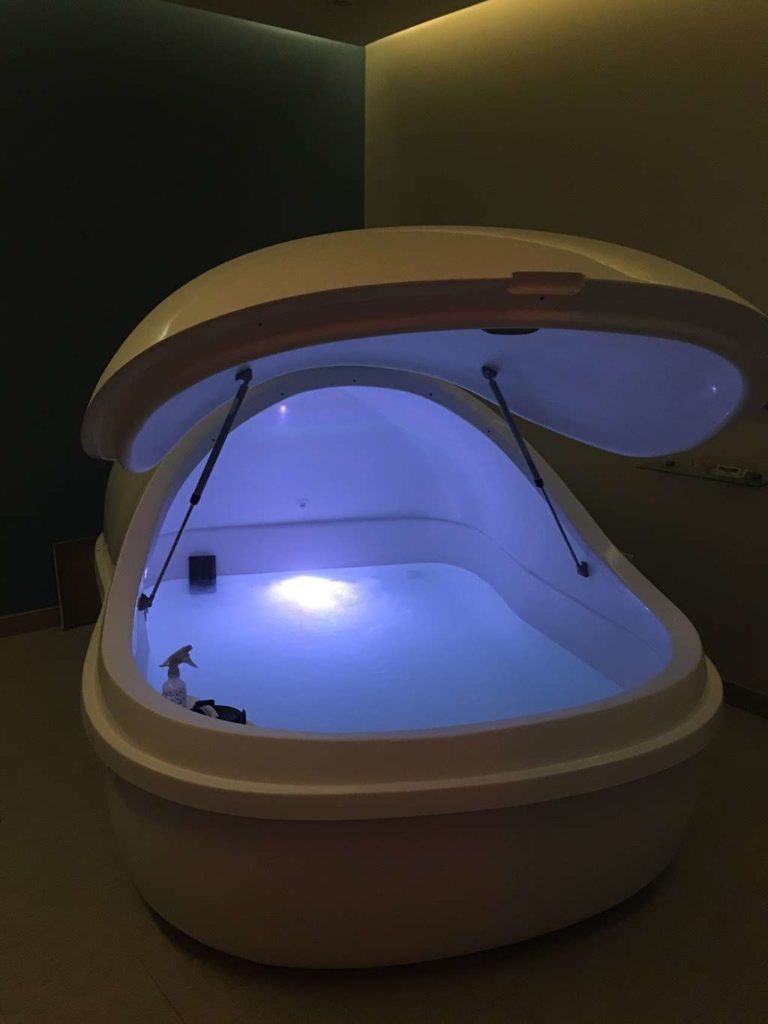
The first time I heard about a “sensory deprivation tank” was when a coworker was going to one for a work event. He was so excited that he researched EVERYTHING about float therapy – how to prepare for it, what to do or not do, etc. The next day, when I asked him how it went, he said it was awful. A light in the pod wouldn’t stop flashing and he had a terrible itch on his nose he was afraid to scratch for fear of getting salt water in his eyes.
Ever since then, I’ve been intrigued on what deprivation tanks actually are, the health benefits behind them, and how to properly prepare. After I finally found a decent place via Groupon, I knew I had to give it a try.
What is float therapy and what are the benefits?
Imagine lying in a pool or the ocean, floating without effort. Sounds relaxing, right? That’s essentially what floating in a deprivation tank should simulate. A pod made for this sole purpose is filled with about 10 inches of warm water, mixed with 1,000 pounds of epsom salt. Due to the salinated water, your body should feel as though it’s in a zero-gravity environment, cutting off your gravitational senses to make you feel like you’re floating on air. The experience is intended to be therapeutic, as a source of relaxation for the body and mind.
How was the experience?
The Groupon package I bought allowed for two people, so I brought my fiancee. The location only had one pod so we took turns. Prior to going into the room, we watched a short video which informed us to let go of any expectations since the experience differs from one person to the next. It also mentioned that the first time may result in sleepiness and exacerbated muscle or joint discomfort if you have chronic pain, but subsequent visits should be contrary.
I went first. The attendant brought me into the room with the pod, gave me some quick instructions, and left me to it. After showering, I placed in my earplugs, climbed into the pod, closed it shut, and pressed a start button. I was instantly surprised by how I was floating in the pod without thought. By default, zen-like music was playing through speakers within and a dim light was shining. Either can be turned off if you prefer. I tried for a brief moment during my session, but decided to keep the light on since I felt entrapped without it.

Throughout my time in the deprivation tank, I kept wondering if I was “doing it right”. I closed my eyes a lot and performed breathing exercises, only to keep bumping into the sides, getting slight discomfort in my ever-knotted shoulders, or finding the tank too hot. Since the water needs to be at body temperature and the pod isn’t very large, it gets very humid. I got up a few times to crack open the pod then close it minutes later since the room itself was cold. Every time I got up, the salt water would drip from my hair into my eyes so I would have to use the spray bottle on the side with clean water. It may have been the last 20 minutes when I finally started to relax.
Would you do it again?
Definitely. Despite my uninspired, first time in the deprivation tank, I heard that it can only get better. You’re supposed to feel more rejuvenated, relieve physical pain, and sleep better once your body and mind are used to the sensation (or lack thereof) of float therapy. And, as opposed to my experience, my finacee’s was uplifting. He actually had the visions and dreams that one only hears rumors of from float therapy. He opted to turn both sound and light off and his journey started with visions of fog and lightening, drifting into dreams. The attendant also told me of her similar experiences, where she would float for hours and have amazing, life-changing visions.
What are some tips for first-timers?
1. Eat a light meal an hour before
You wouldn’t want to feel hungry or hear your stomach digesting while in a quiet, secluded pod. Eating a light meal an hour before will ensure proper time to digest and enough sustenance to hold you through your session.
2. Stabilize yourself if you’re hitting the walls
I’m 5’3″, but I still kept floating into the sides of the pod because they’re generally pretty small. If you find yourself bumping into the walls, stretch your arms out until you touch both sides of the wall and hold yourself there for a few seconds before relaxing your arms again.
3. Try breathing exercises and different positions
The video we watched before we went in showed us a few different ways to get comfortable in the pod. One tip was to slowly count to 300, almost like counting sheep. Another was to put our arms and legs in different positions. One that I enjoyed was raising my arms above my head. Even simple changes such as having your palms up instead of down in the water could be a game-changer.
4. Float in the nude
You can wear a swimsuit, but we decided to float naked to rid ourselves of additional distractions. Before going, I read the experiences of others who tried both before. They stated that their swimsuits often clung to their body and didn’t allow them to have a fully immersive time in the pod.
5. Go in with zero expectations
This is probably the KEY to having the most pleasant first experience you could within a deprivation tank. As mentioned, both my fiancee and mine’s first time were on opposite ends of the spectrum. Don’t expect to be fully relaxed or have visions on your first go, since that may be counterproductive.
As with everything in life, stay open-minded, have fun, and don’t be afraid to try again during your journey towards mindfulness, happiness, and tranquility.
~XOXO Kris